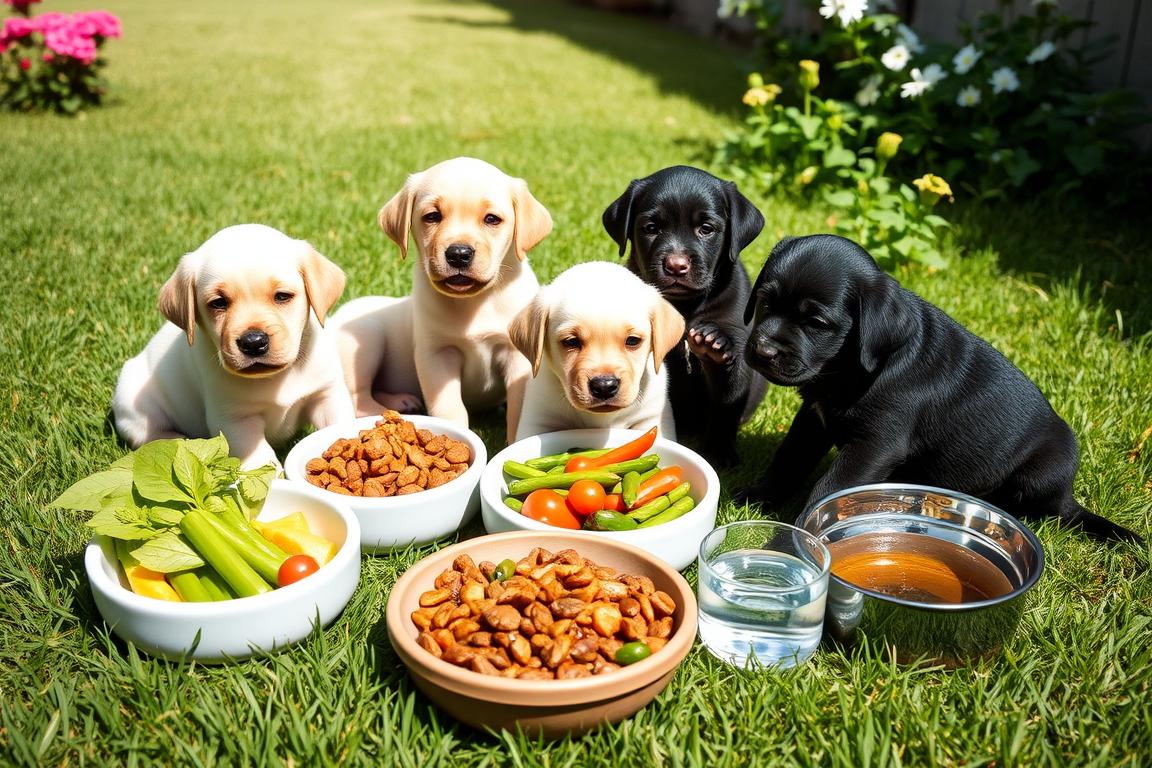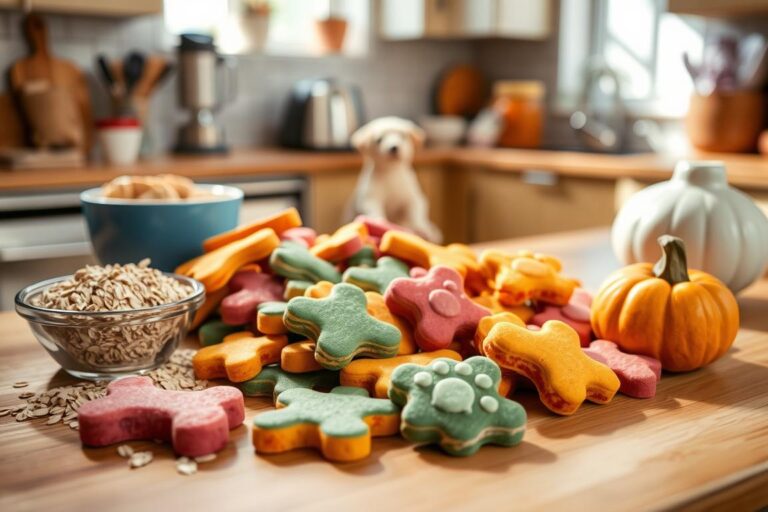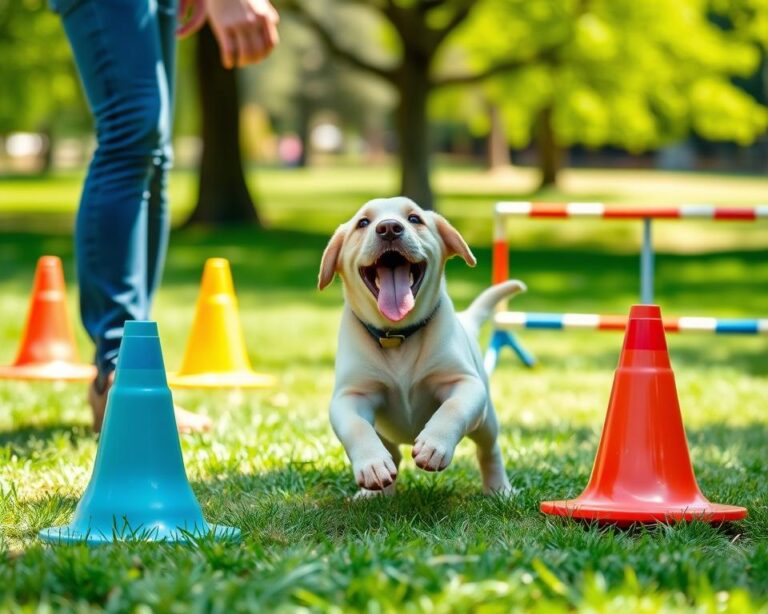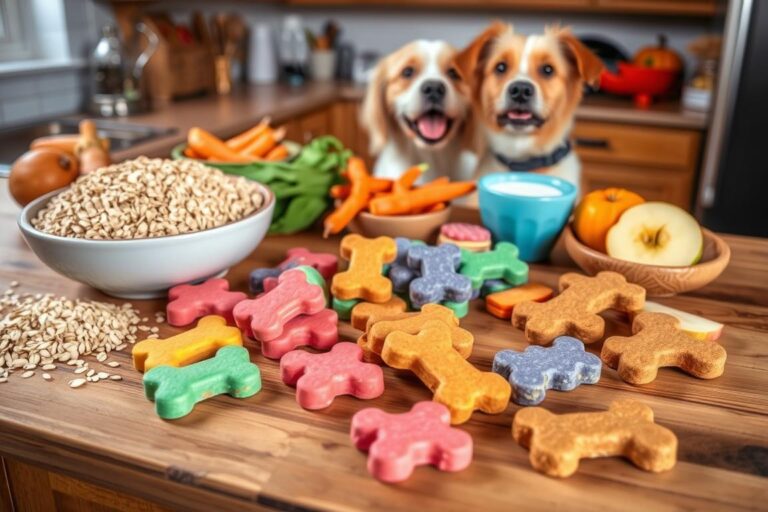Optimal Nutrition for 2 Month Old Labrador Pups
Understanding the right food for our 2-month-old Labrador puppies is key. The right diet helps them grow strong and healthy. It also keeps them from getting sick later on.
Labrador puppies need proteins, carbs, vitamins, and minerals to grow well. It’s also important to feed them the right amount and at the same time every day. This way, we make sure they get the best care as they grow and learn.
Understanding the Nutritional Needs of Labrador Puppies
Labrador puppies need special nutritional needs for labradors to grow well. They grow fast and need the right mix of proteins, fats, and carbs. It’s key to meet their 2 month old labrador nutritional requirements for muscles, bones, and energy.
They also need vitamins and minerals for health and energy. Choosing the right food is very important. Foods like Burgess Sensitive Dog food get lots of good reviews for puppies.
Knowing what labrador puppy nutrition they need is crucial for a healthy life. Watch their growth and adjust their food as needed. Keep treats to 10% of their daily food to avoid too much weight.
The Importance of a Balanced Diet
A balanced diet is key for Labrador puppies to grow healthy. They need the right mix of nutrients. This includes proteins, carbs, vitamins, and minerals for their well-being.
The Role of Proteins and Carbohydrates
Proteins and carbs are important for puppies. Proteins help with growth and muscle. They should come from good animal or plant sources.
Carbs give energy for daily play. Choose complex carbs for steady energy. A good diet has the right amount of these nutrients.
Vitamins and Minerals Essential for Growth
Vitamins and minerals are also vital for puppies. Vitamins A, D, and E, and minerals like calcium, help bones and immune health. Puppies need calcium for strong bones.
A diet rich in these nutrients helps puppies stay healthy. It prepares them for a strong adulthood.
Best Food for 2 Month Old Labrador Puppy
Choosing the right food for a 2-month-old Labrador puppy can be tough. There are so many options out there. It’s important to pick high-quality kibble made for big puppies. Look for brands that give a balanced diet for fast growth and lots of energy.
Brands like Royal Canin and Eukanuba are great. They offer the nutrients Labrador puppies need.
Good puppy food for Labradors has 28% to 30% protein. This comes from meat like chicken or lamb. It also has at least 18% fat and 22% carbs. This mix helps puppies grow strong and healthy.
Make sure the food meets AAFCO standards. This ensures it’s good for growth and health.
Here’s some important nutritional info for puppy food:
| Nutrient | Recommended Content |
|---|---|
| Crude Protein | 31.0% |
| Crude Fat | 12.0% |
| Crude Fiber | 3.7% |
| Moisture | 10.0% |
| Calcium | 1.15% |
| Phosphorus | 0.96% |
| Vitamin E | 420 IU/kg |
| Glucosamine | 743 mg/kg |
| Chondroitin Sulfate | 8 mg/kg |
| Metabolizable Energy | 3567 kcal/kg (307 kcal/cup) |
Pro Plan is a top choice for Labrador puppies. It’s made with quality ingredients. Plus, it’s easy to find, even when other brands are hard to get.
Types of Puppy Food Options
Let’s look at the different foods for Labrador puppies. Each food type affects their growth and health. Puppies can do well on dry kibble, wet food, or raw diets. We need to think about the good and bad of each when choosing food for our puppies.
Kibble vs. Wet Food: What’s Better?
Kibble is easy to use, affordable, and helps keep teeth clean. Kibble like Royal Canin Labrador Puppy is great for puppies from 8 weeks to 14 months. Wet food, however, is more tasty and keeps puppies hydrated. But, it costs more and must be kept cold after opening.
Exploring Raw Diets for Labrador Puppies
Some pet owners choose a raw diet for their puppies. This diet, called BARF, includes raw meat, bones, fruits, and veggies. It can be very nutritious but needs careful planning and safety. Raw diets might not be for everyone because they’re complex and can be risky if not done right.
Feeding Schedule for Labrador Puppies
It’s very important to feed our Labrador puppies right. They start eating four times a day when they are about eight weeks old. As they get older, we can change to three meals a day.
Recommended Frequency of Meals
Puppies under six months need four meals a day. This helps them grow fast and digest food well. By twelve weeks, they might eat three meals a day but still get the same amount of food.
Watch for when they grow a lot. Puppies might eat three cups of food at eleven weeks. Then, they go back to two cups by twelve weeks.
How to Transition Feeding Amounts as They Grow
As our puppies grow, we need to adjust how much food they eat. An eight-week-old Labrador might eat about 50 grams of food at each meal. We should watch their weight and health closely.
As they get closer to six months, they might eat 2-3 cups of kibble a day. Eating less often helps them stay healthy and learn good eating habits.
| Age | Daily Food Intake | Number of Meals |
|---|---|---|
| 8 Weeks | 2 cups | 4 meals |
| 11 Weeks | 3 cups (during growth spurt) | 4 meals |
| 12 Weeks | 2 cups | 3 meals |
| 14 Weeks | 2-3 cups | 3 meals |
| 6 Months | 2-3 cups | 2-3 meals |
Choosing High-Quality Puppy Food Brands
Choosing the right puppy food is key for our Labrador puppies to grow well. There are many brands out there. We need to know what makes a brand good. This section will show us the best brands for Labradors and how to read food labels.
Top Puppy Food Brands for Labrador
Some puppy food brands are known for their quality and nutrition. Royal Canin and Purina Pro Plan are great for big puppies. Royal Canin has special diets but costs more. Purina Pro Plan is loved for being affordable and vet-approved.
Here’s a look at some popular puppy food brands:
| Brand | Protein % | Fat % | Carbohydrates % | Fat-to-Protein Ratio |
|---|---|---|---|---|
| Purina Pro Plan | 30% | 18% | 22% | 60% |
| Royal Canin | 28% | 18% | 22% | 64% |
| Wellness Core Large Breed | 38% | 13% | 41% | 35% |
| Taste of the Wild High Prairie | 36% | 20% | 36% | 56% |
| Canidae All Life Stages | 27% | 16% | 49% | 60% |
Reading Puppy Food Labels Effectively
Using a puppy food label guide helps us choose well. Look for at least 28% – 30% protein from animals and 18% fat. Avoid grain-free foods for Labradors. Check the ingredients for fillers and compare prices per pound.
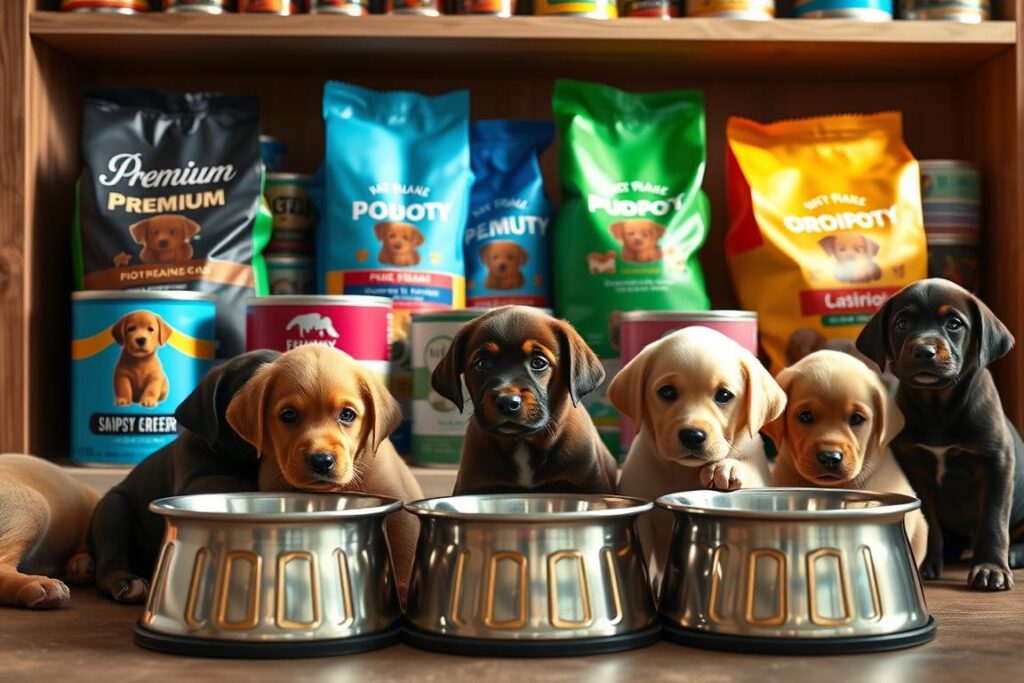
Portion Control: Avoiding Overfeeding
It’s very important to control how much food our puppies eat. Too much food can make them fat and sick. We need to know how much food they need to stay healthy.
At first, Labrador puppies need to eat four small meals a day. This helps their growing bodies digest food better. As they get older, we can start giving them fewer meals. By five months, they might only need two meals a day.
Following the food packaging’s guidelines can make feeding easier. Most puppy foods have charts that tell us how much to feed based on their weight and age. This helps us feed them just right.
Don’t forget about treats and snacks. They should be less than 10% of their total food. This helps them grow right and avoid bone problems. Labradors are more likely to have bone issues if they eat too much.
It’s a good idea to talk to vets and breeders about the best food for our puppies. We should also watch their weight closely. Giving them the right amount of good food helps them grow strong and stay healthy.
| Age (Months) | Meals per Day | Approximate Feeding Amount (grams) |
|---|---|---|
| 2 | 4 | 250 – 300 |
| 3 | 4 | 300 – 350 |
| 4 | 3 | 350 – 400 |
| 5 | 3 | 400 – 450 |
| 6+ | 2 | 450 – 500 |
Special Nutritional Considerations for Growing Labradors
Labrador puppies need special food as they grow. They need food that helps their joints. This is because they can get joint problems easily.
Adding things like glucosamine to their food helps their joints grow strong. This is very important during their growing years.
The Importance of Joint Health Provisions
Labradors often get hip dysplasia and other joint issues. We need to give them food that helps their joints stay healthy. This food should also help them move well.
Special dog food, like Royal Canin Labrador Retriever Adult Dry Dog Food, is good. It has nutrients that make their bones strong and joints less sore.
Monitoring Weight and Health During Growth
It’s important to watch how your puppy grows and eats. We should check their weight often. This helps us know if we need to change their food.
Watching their weight helps avoid obesity and health problems. We should also look at their shape and energy. This helps us keep their diet right for their growth.
How to Safely Introduce New Food
Changing puppy food needs to be done slowly to avoid upset stomachs. We suggest a gradual change over five to seven days. This lets your puppy’s body get used to the new food easily.
Gradual Transition Techniques
To make the change smooth, mix the old and new food in a certain way:
| Day | Old Food Ratio | New Food Ratio |
|---|---|---|
| 1-3 | 75% | 25% |
| 4-5 | 50% | 50% |
| 6-7 | 20% | 80% |
This plan helps avoid stomach problems. About 12% of dogs might have food allergies or bad reactions. Changing food too fast can cause discomfort like diarrhea.
Signs of Food Sensitivity or Allergies
It’s important to know the signs of food allergies in puppies. Symptoms include upset stomachs, skin problems, or acting differently. If you see these signs, stop the new food and go back to the old one.
Usually, going back to the old diet for a few days helps. It makes your puppy’s stomach feel better.
Hydration: Importance of Water Intake
Keeping puppies hydrated is key for their health and growth. Young puppies need about half a cup of water every two hours. Older puppies need half an ounce to one ounce of water for each pound of body weight daily.
Always give fresh, clean water to our pups. This is especially true when they eat dry kibble or it’s hot outside. Wet food has more moisture than dry kibble, which helps with staying hydrated.

Watch for signs of dehydration like dry gums. A quick test is to pinch the puppy’s neck and see how fast it goes back. Too much thirst or pee can mean health problems.
Make sure our Labradors drink the right amount of water. They need 40-60 ml of water for each kilo of body weight. If they drink too much or pee too often, see a vet. This could mean kidney disease or diabetes.
Feeding Tips for Happy, Healthy Labradors
Creating a joyful and healthy feeding environment for our Labradors is key. We need to follow best practices for puppy feeding. This makes mealtime a positive experience.
Feeding at the same times every day helps. It makes our puppies feel safe and know when to eat. This routine is good for their happiness and health.
Best Practices for Feeding Times
Labrador puppies should eat three to four small meals a day. As they grow, we can switch to two meals. This helps them stay active without eating too much.
Feeding in a quiet spot helps them focus. It’s also smart to avoid free feeding. This can prevent them from eating too much and getting fat.
The Influence of Treats on Nutrition
Treats are great for training and rewarding good behavior. But, they should only be 10% of our puppy’s daily food. This keeps their diet balanced and prevents weight gain.
Choosing healthy treats like small fruits or puppy treats is good. But, remember to use them in moderation. Too many treats can harm their diet and health.
| Feeding Schedule | Puppy (2-6 Months) | Adult (Over 12 Months) |
|---|---|---|
| Meals per Day | 3-4 | 2 |
| Percentage of Treats | Max 10% | Max 10% |
| Food Focus | High-quality puppy food | High-quality adult food |
By following these tips, we can make our Labradors happy and healthy. A nice mealtime atmosphere and careful treat use help them grow well. This ensures a long, happy life together.
Common Mistakes in Puppy Feeding
Welcoming a new Labrador puppy is exciting. But, we might forget about their nutrition. Mistakes in feeding can harm our puppies’ health and growth.
One big mistake is overfeeding. We might think more food means faster growth. But, it can cause obesity and health issues. A 2-month-old Labrador needs about 4 1/2 cups of food a day.
Feeding schedules are key. Puppies need four meals a day at first. Then, switch to three meals by three months and two meals later.
Feeding table scraps can upset their stomachs. Premium foods like Purina Pro Plan have good nutrients. Cheaper foods might have fillers that cause problems.
Changing their diet too fast is another mistake. Switch foods slowly over 7-10 days. Watch for loose stools, which could mean health issues.
| Error Type | Consequences | Solution |
|---|---|---|
| Overfeeding | Obesity and related health issues | Follow recommended feeding guidelines based on age and weight |
| Feeding table scraps | Nutritional imbalances | Stick to quality puppy food designed for Labradors |
| Sudden diet changes | Gastrointestinal upset | Transition food gradually over 7-10 days |
| Skipping meals | Unpredictable digestive cycles | Maintain a consistent feeding schedule |
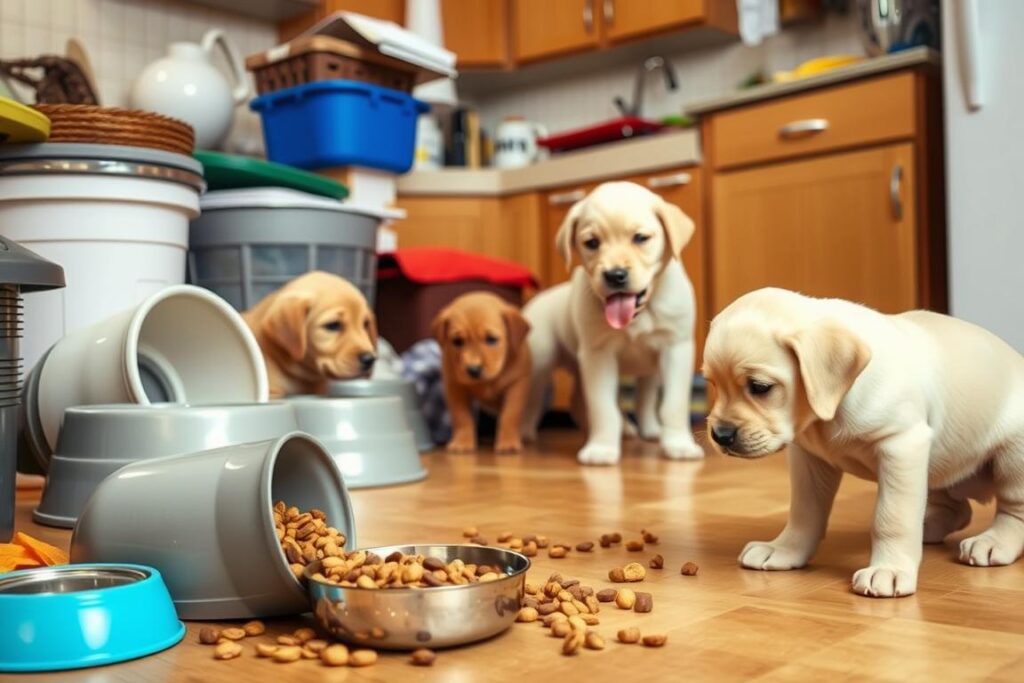
Consulting Your Veterinarian for Dietary Advice
Ensuring our Labrador puppies are healthy is key. Getting veterinary advice for puppy diet is crucial. A vet can help us find the best food for our growing pups.
They guide us in making diet changes. They watch how our pups grow and stay healthy. This helps us fix any health issues early.
By consulting our vet for puppy nutrition, we learn a lot. They consider our puppies’ weight, how active they are, and any health issues. Vets know the best food, how much, and when to feed it.
Choosing the right food is just the start. It’s also about working with a vet to change the diet as our pups grow. This way, their nutritional needs are met at every stage of their development.

